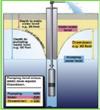|
|

|
|
Well dynamics - Theis Solution
Theis (1935) presented an exact analytical solution for the transient drawdown in an infinite uniform confined aquifer. Use an analytical approach to calculate the influence of radius for the given parameters. Then develop a MAGNET model to reproduce the Theis solution and to perform sensitivity analysis with respect to aquifer parameters and pumping rate.
(Well Hydraulics - 14)
|
|

|
|
Radius of Influence
The Radius of Influence, R(t), is the horizontal radial distance from a well to the points in an aquifer where there is negligible influence from pumping. Show that R(t) is proportional to sqrt(T/St); explain why why the impact of pumping on a confined aquifer is dramatically larger than that on a unconfined aquifer; and develop a MAGNET model that can reproduce the Theis solution and perform a sensitivity analysis with respect to hydraulic conductivity, storage coefficient, and time.
(Well Hydraulics - 14)
|
|

|
|
Well Interference Dispute II
Beginner to Advanced - analytical and numerical sub-problems, which can be done sequentially or individually. Background: A dispute has arisen between two farmers after one of the farmers installed a 500 GPM irrigation well 2000 ft. from the small domestic water supply well of the other farmer (see above). After the irrigation well had been operating for 3 months it was observed that the water level in the domestic well had declined over 30 feet. The owner of the domestic well claims that the decline in water level in his well is due to pumping from the irrigation well and is trying to restrict that pumping. The owner of the irrigation well claims that the decline is related to the recent drought; he has been advised that the "radius of influence"" of his well is at most 500 feet."
(Well Hydraulics - 14)
|
|

|
|
Well Conflict Resolution
Beginner to Advanced - analytical and numerical sub-problems, which can be done sequentially or individually. Background: A dispute has arisen between two farmers after one of the farmers installed a 500 GPM irrigation well 2000 ft. from the small domestic water supply well of the other farmer (see above). After the irrigation well had been operating for 3 months it was observed that the water level in the domestic
(Well Hydraulics - 14)
|
|

|
|
Well interference Dispute III
A dispute has arisen between two farmers after one of the farmers installed a 500 gpm irrigation well 2000 ft. from the small domestic water supply well of the other farmer. After the irrigation well had been operating for 3 months it was observed that the water level in the domestic well had declined over 30 feet. Determine whether it is possible for the water level decline in the domestic well to be produced by pumping from the irrigation well.
(Well Hydraulics - 14)
|
|

|
|
Specific Capacity
Specific capacity is defined as the rate of discharge of a well per unit depth of drawdown. Probe analytical solutions and develop a MAGNET model to simulate flow in a specific area given specific capacity measurements distributed across space.
(Well Hydraulics - 14)
|
|

|
|
Pumping near an impervious boundary
The drawdown due to pumping will be greater near the boundary when a confined aquifer is bounded on one side by a straight-line impermeable boundary. Develop a MAGNET model that can reproduce the analytical solution by applying the model to a specific situation.
(Well Hydraulics - 14)
|
|

|
|
Pumping Near a Recharge Boundary
When a Confined aquifer is bounded on one side by a straight constant head boundary, drawdown due to pumping will be less near the boundary.
(Well Hydraulics - 14)
|
|

|
|
Water Withdrawal Assessment
When pumping near a stream, we are interested not only in the resulting drawdowns, but also in the depletion of the stream flow, resulting in potentially adverse impact of groundwater dependent ecosystems. Develop a more general MAGNET numerical model that can reproduce the above analytical solution and perform a sensitivity analysis of stream depletion with respect to the following parameters: aquifer conductivity; storage coefficient; regional hydraulic gradient; stream bed leakance; heterogeneity; presence of other interacting sources and sinks.
(Well Hydraulics - 14)
|
|

|
|
Aquifer test design
You are asked to design an aquifer pumping test using MAGNET in an unconfined aquifer consisting of outwash sand similar to that on Cape Cod. Your design should include specific recommendations of pumping rate, test duration, and any other factors which you consider to be important.
(Well Hydraulics - 14)
|
|
|
|